Broccoli is an edible flower. Broccoli is a cool-season crop. Grow broccoli so that it comes to harvest when temperatures average no more than 75°F (23°C) each day.
Broccoli heads are clusters of tightly packed flower buds waiting to open. Broccoli is a hardy biennial, grown as an annual. It is a member of the cabbage or cole family. The flower stalks are green, purple, or white. The flowers are all yellow, but they are commonly eaten before they open, while they are still in bud, and before they bloom.
Related articles:
- Seven Ways to Cook and Serve Broccoli
- Broccoli Seed Starting Tips
- How to Plant and Grow Broccoli
- Broccoli Growing Problems Troubleshooting
- How to Harvest and Store Broccoli
- How to Grow Broccoli Raab
Plant broccoli in late winter or early spring for spring and early summer crops. Plant broccoli in mid to late summer or early fall for late winter or early spring crops.
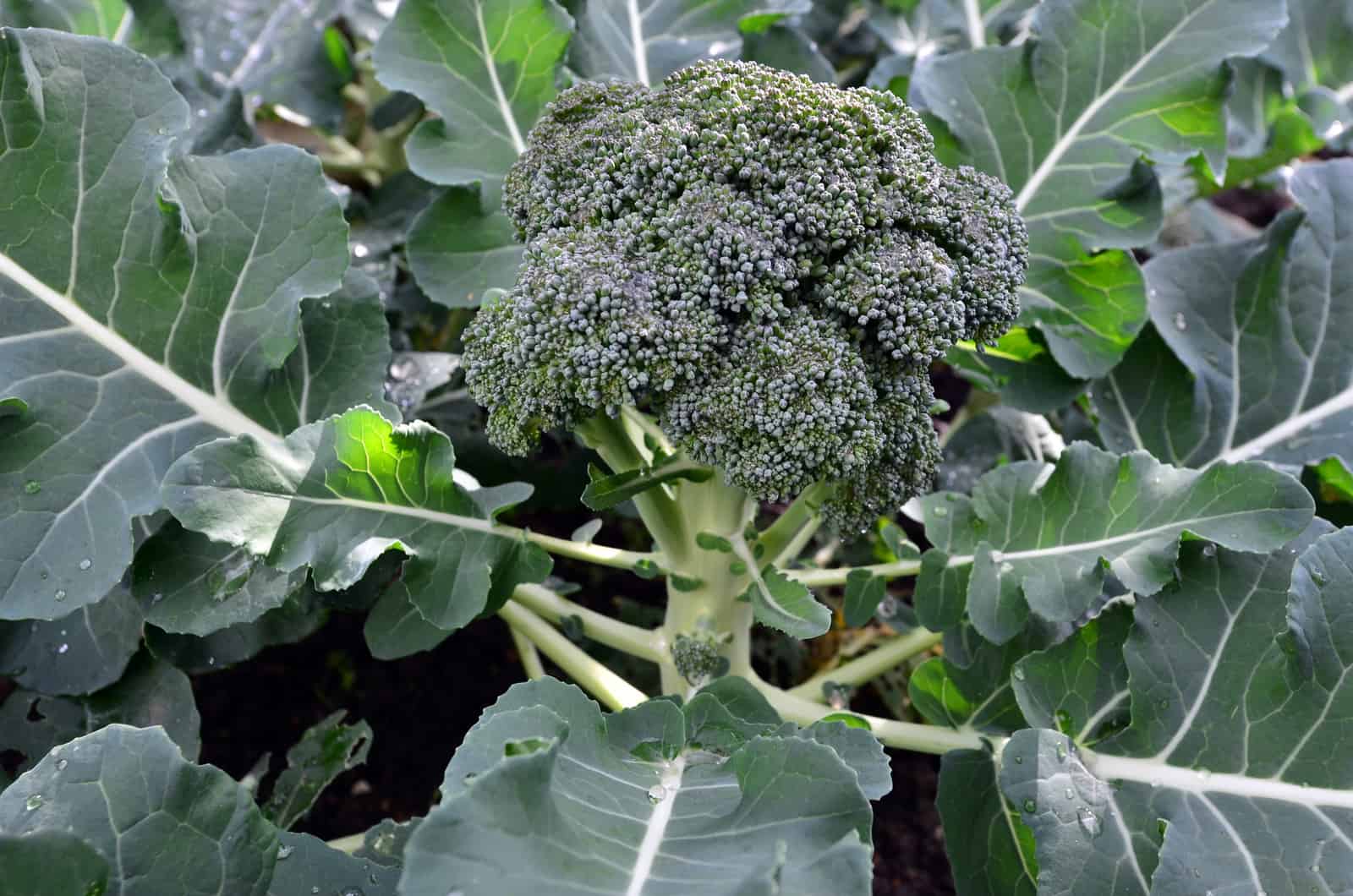
Broccoli needs cool weather to grow–warm weather will cause the buds to “rice” or open as flowers.
Broccoli is suited for springs that are long and cool or autumns where there is no Indian summer. Where winters are mild, start broccoli in fall for harvest in spring.
Broccoli is a cut-and-come-again crop. Instead of cutting the whole plant to the ground at harvest time, cut only the main head. When the main head is removed, the plant will grow more side sprouts at leaf joints. Side sprouts of smaller heads provide a second and sometimes a third harvest from each plant.
Broccoli is a common dinner side dish. It is rich in vitamins A, B, and C, as well as calcium and phosphorus. Broccoli florets and stalks (with pithiness peeled away) can be eaten raw, steamed, or stir-fried. Broccoli florets are tasty with a dash of lemon juice or a topping of melted cheese. Use raw broccoli in salads or with dips. Steam broccoli or use it in stir-fries or cream soups or add broccoli to casseroles.
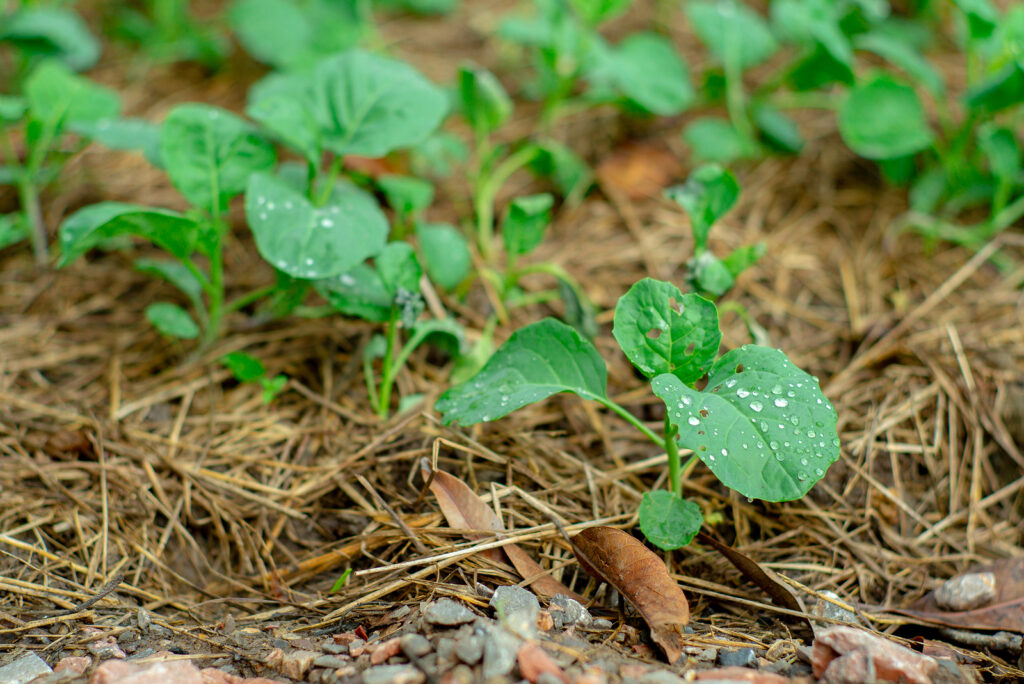
Grow broccoli in cool weather for the best harvest
Broccoli is best—bigger and most flavorfully sweet—when it reaches maturity in cool weather.
Mid- to late-summer is a good time to plant broccoli—the cool days and nights of autumn will arrive in the weeks before the tight florets of broccoli are ready for cutting. Broccoli is frost tolerant—so even if it turns unexpectedly cold, you will have a tasty crop.
Spring-planted broccoli must come to harvest in cool weather as well. If you plant broccoli in spring, be sure to allow enough time for the variety you grow to reach harvest before the days grow long and warm. Spring-planted broccoli can be bitter if very warm temperatures arrive too soon.
Start fall broccoli 10 to 12 weeks before your average first frost date in fall; protect plants with row covers if the weather turns frosty. Spring broccoli should reach harvest before daytime temperatures reach the mid-60s°F consistently; protect young seedlings from frost with row covers to get them started in the garden early.
Broccoli can be direct seeded, but for fall planting start plants in peat pots and then transplant seedlings into the garden filling spaces vacated by warm-weather crops as they finish their season.
Planting broccoli for a sustained harvest
For a sustained harvest choose broccoli varieties with good side shoot production—they will keep producing after the main stalk or shoot has been harvested–or plant several varieties with differing days to maturity. (Broccoli has a branching habit. It grows 2 to 3 feet tall and forms a central stalk on which will grow its main edible flower or head; when the central flower is cut away, side branches, called sideshoots, lengthen and produce small flower heads, which are also edible.) Hybrid varieties are a good choice if you want an all-at-once harvest; they are more uniform than open-pollinated varieties that have less-uniform maturity rates.
Choose between heading-type broccoli which forms one large head of flower buds on a central stock (some heading varieties will produce sideshoots once the central head is cut), or sprouting-type varieties which form a lot of button-sized small florets in leaf axils. A dozen plants will feed a large family.
Whichever type of broccoli you choose, keep in mind that one cup of cooked broccoli has more vitamin C than an orange and as much calcium as ¼ cup of milk; broccoli is also a good source of vitamin A, potassium, folate, iron, and fiber.

Here is your complete guide for growing broccoli.
Broccoli growing quick tips
- Start broccoli seed indoors 5 to 6 weeks before the last frost in spring for spring planting.
- Start broccoli in the garden in mid to late summer to grow a late fall or early winter crop. In mild winter regions, plant in fall for winter harvest.
- Transplant broccoli seedlings to the garden when they are 4 to 6 weeks old, as early as the last frost in spring, after hardening off the seedlings for 4 days.
- In mild-winter regions, start seeds indoors in late summer and set them in the garden in autumn for winter harvest.
- Broccoli will come to harvest in 55 to 85 days when grown from transplants and 70 to 100 days when grown from seed.
See Garden Products Recommended by Harvest to Table
Broccoli yield. Plant 2 to 4 broccoli plants for each household member.
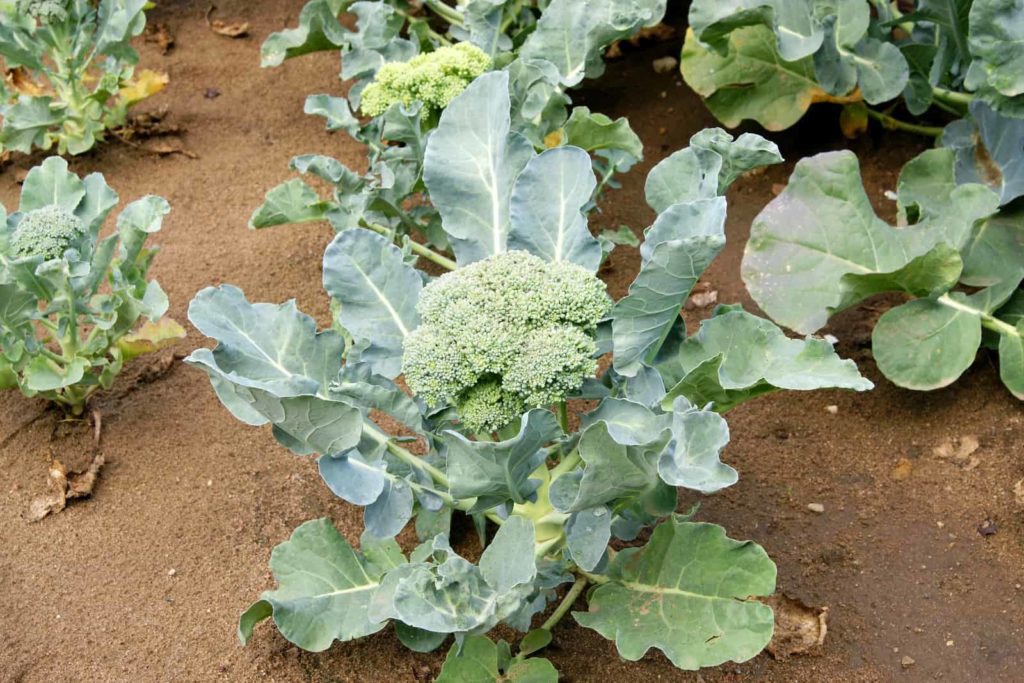
Broccoli planting time
Broccoli is a cool-season vegetable that requires from 40 to 90 days to reach harvest depending upon the variety. Broccoli grows best in temperatures that range from no more than 80ºF (27ºC) during the day to about 60°F at night. Broccoli is frost-hardy and can tolerate temperatures as low as 20ºF. Temperatures that are too cold or too warm will cause broccoli to bolt without forming a head. Plant broccoli so that it comes to harvest during cool weather.
Sow broccoli seeds in early spring for an early summer crop or in midsummer for a fall crop. In mild-winter regions, sow broccoli from fall to late winter. Time your planting so that harvest comes before the weather warms into the 70sF (21sC); the florets will open in warm weather and become inedible.
- Broccoli is a cool-weather crop that must come to harvest before temperatures rise consistently above 75°F (24°C).
- Broccoli is commonly grown from transplants set in the garden. Broccoli will germinate in the soil as cool as 40°F.
- Start broccoli seed indoors 5 to 6 weeks before the last frost in spring.
- Transplant broccoli seedlings to the garden as early as 4 weeks before and 2 to 3 weeks after the last frost in spring after hardening seedlings off for 4 days.
- For best growth, set transplants in the garden after the soil has warmed to 60°F.
- In mild-winter regions, start seeds indoors in late summer and set them in the garden in autumn for winter harvest. Whether that is too cold or too warm will cause broccoli to go to seed without forming heads.
- In cold winter, short-season regions start broccoli in summer for fall harvest.
- As a general rule, start a fall crop 18 weeks before the first expected frost.
- Broccoli grows best where air temperatures range between 45° and 65°F (7.2-18°C).
- Broccoli is frost-hardy and can tolerate temperatures as low as 20°F (-6.7°C).
Broccoli planting calendar
Planting for spring harvest
Sow broccoli seeds 4 to 6 weeks before your region’s average last frost date for a late spring harvest.
Planting for autumn and winter harvest
For a fall or winter harvest, transplant broccoli seedlings into the garden in midsummer in the North. In mild winter regions such as the South and Southwest, broccoli can be planted in the fall. In cold regions, broccoli should come to maturity before the freezing weather sets in; protect broccoli in a plastic tunnel for harvest into winter.
Sow broccoli 85 to 100 days before the average first fall frost—that will be in mid- to late-summer in most regions. If you are growing broccoli from starts or transplants just count backward from the average first fall frost the number of days to maturity that you see on the plant label.
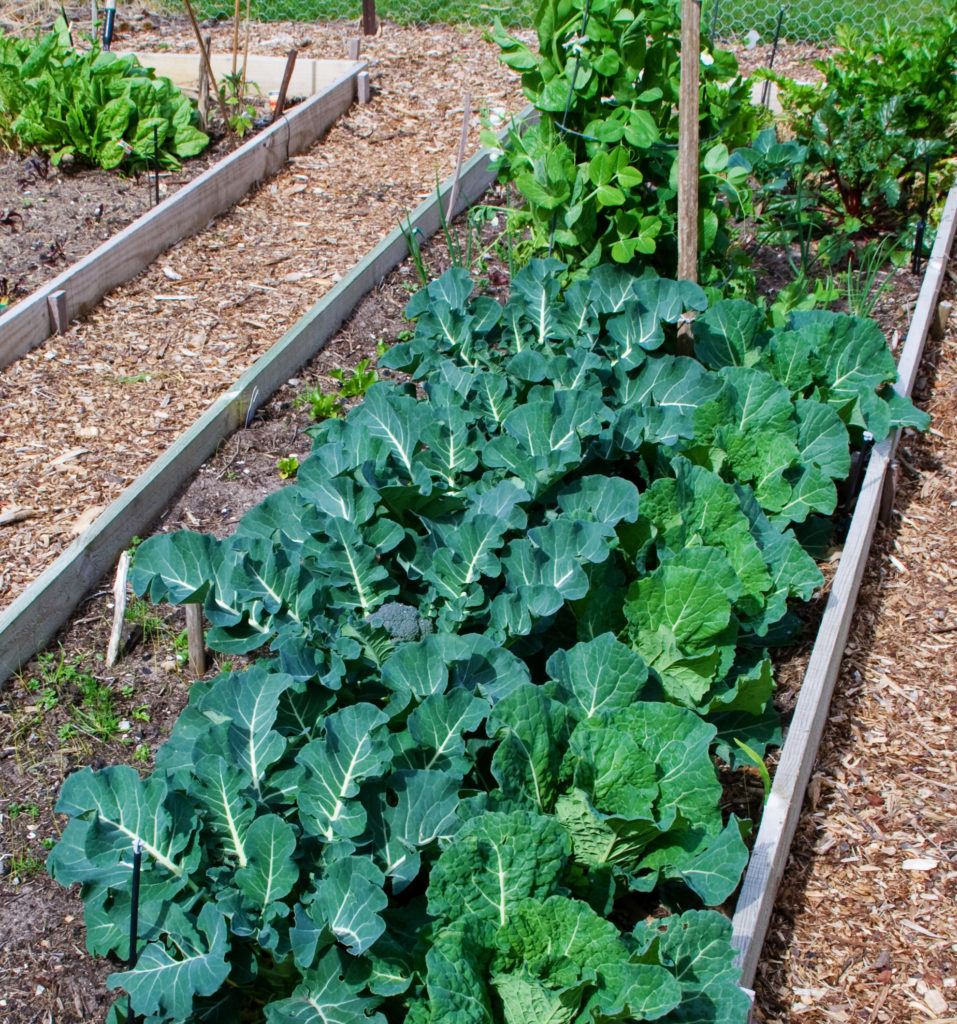
Where to plant broccoli
Plant broccoli in full sun in slightly acidic soil (pH between 6.0 and 6.8). Turn 2 to 4 inches of well-aged compost and a thin layer of aged manure into the planting bed before planting. Broccoli grows best in full sun, but will grow in light shade. Broccoli is not a suitable crop for very hot climates.
Broccoli prefers rich, well-drained soil with a neutral pH within the 6.5 to 7.5 range. Work plenty of compost into the soil at planting time.
- Plant broccoli in full sun.
- Broccoli grows best in nitrogen-rich soil that is well-drained soil.
- Add plenty of aged compost or well-rotted manure into the soil 2 weeks before planting. (Fresh manure can be added to soil in the fall for spring planting.) The addition of aged compost and aged manure ensures fertile soil.
- Broccoli wants a soil pH between 6.7 and 7.2. Add lime to the soil to achieve a higher pH if clubroot disease is a problem. (Lime inactivates the clubroot organism.)
- In regions where there is heavy rain or sandy soil, aged compost should be added to the soil to supplement soil nitrogen.
More tips: Broccoli for Cool Weather Harvest.
Seed starting broccoli
Start broccoli seed indoors 8 weeks before transplanting seedlings to the garden. Sow seeds in a warm, well-lighted location—in a bright window or under grow lights. Sow seeds 1/4″ (6 mm) deep in the seed starting mix. Firm lightly and keep the mix just moist. Seedlings emerge in 10-21 days at 50-85°F (10-29°C). Sow seed outdoors when the soil temperature is at least 65°F (18°C).
Seedlings can be transplanted into the garden when they are 4-5” (10-13 cm) tall after the last hard frost in spring. Move seedlings to a sheltered place outdoors to “harden off” 1 week before transplanting.
- Sow seed ½ inch deep and 3 inches (7.6cm) apart.
- Plant transplants that are 4 to 6 weeks old with four or five true leaves.
- Space plants 15 to 18 inches apart in intensively planted beds, 18 to 24 inches apart in rows with rows 24 to 36 inches apart. Set transplants slightly deeper in the ground than they were in the pot.
- Leggy transplants or transplants with crooked stems can be planted up to their first leaves so that they will not grow top-heavy.

Spacing broccoli
Space broccoli plants in the garden 16 inches (41 cm) apart in rows 24 inches (61 cm) apart. Sow broccoli seeds ½ inch deep and 3 inches apart. When seedlings are big enough to lift by their true leaves, about 4 to 6 weeks old, thin seedlings to 18 to 24 inches apart in wide beds or blocks. Rows should be spaced 24 to 36 inches apart. Thinned seedlings can be transplanted to another part of the garden. Transplants that are leggy or have crooked stems can be planted up to their first leaves so that won’t grow to be top-heavy.
- Plant seedlings 18 to 24 inches (45-61cm) apart in rows 24 to 36 inches (61-91cm) apart.
- Plant seeds and transplants at the same time for succession crops or plant early and midseason varieties at the same time.
- Transplant thinned seedlings to another part of the garden.
- Thin plants when they are 1 inch tall; cut thinned plants off at the soil level with a scissor.
- Place cutworm collars around young seedlings.
More tips: Broccoli Seed Starting Tips.
Broccoli companion plants
- Good companion plants for broccoli are beets, celery, herbs, onions, and potatoes. Avoid planting broccoli near pole beans, strawberries, or tomatoes.
- Broccoli grows to about 2 feet tall and wide; broccoli requires a good amount of space. During early growth, fill the space between broccoli plant with quick-growing vegetables such as lettuce and radishes.
See Garden Products Recommended by Harvest to Table
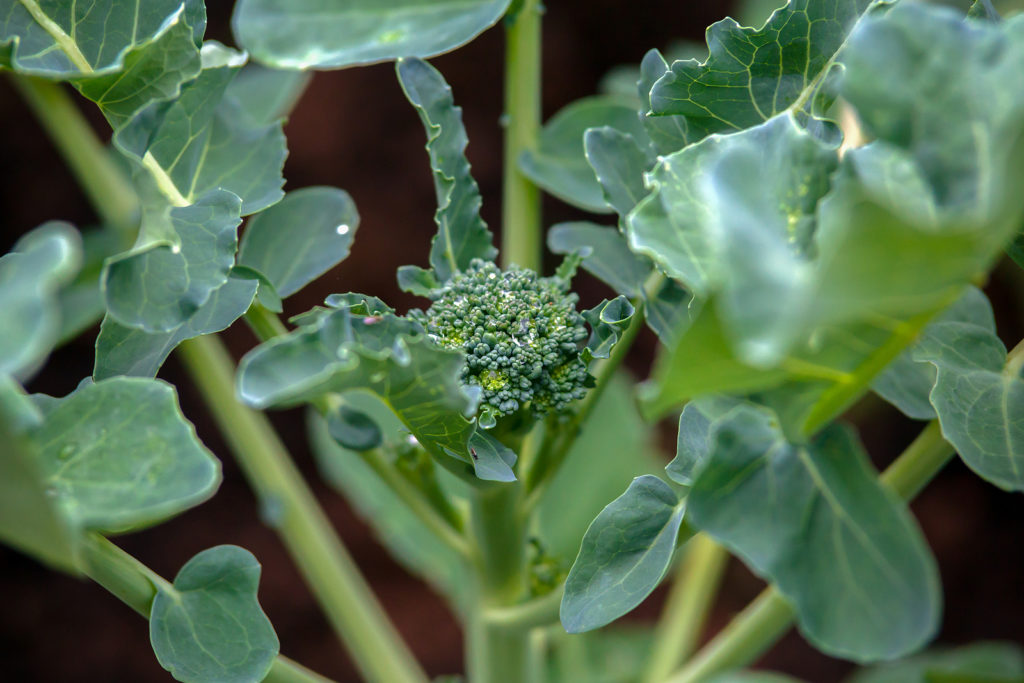
Container growing broccoli
Broccoli can be grown in a container 8 inches deep. Set plants at least 18 inches apart in large containers. Containers can warm quickly and broccoli is sensitive to heat so move containers into the shade on very warm days. Broccoli grown in containers is more easily protected from the cold in the early spring; set out earlier in spring that transplants into the garden.
- One broccoli plant will grow in an 8-inch (20cm) container.
- Grow multiple plants in larger containers set 18 inches (45cm) apart.
- Broccoli is very sensitive to heat so be sure to move plants into the shade on hot days.
Four stages of broccoli growth
Broccoli has four stages of growth:
- The rapid growth of leaves.
- Formation of the head (flower bud), the part that is eaten.
- Resting period while the embryonic blossoms are being formed.
- Development of the stalk, flowers, and seeds.
Head formation is essential for the production of the vegetable we eat. Broccoli that is hit by severe frost, lack of moisture, or too much heat will bolt–produce flower petals and seed–before the head of tight buds is formed.
Watering broccoli
Broccoli should be well watered from the outset. Give broccoli regular watering for the best growth. Keep soil moist but not wet. Cut back on watering as the heads approach maturity and harvest.
- Broccoli needs a regular supply of water to produce good heads. Keep soil moist during the growing season. Soil moisture can be measured with your index finger: stick your finger into the soil, if it comes away dry, it is time to water.
- Water broccoli at the base of the plant.
- Give broccoli from 1 inch to 2 inches of water each week. One inch of water equals 16 gallons (60.5 liters).
- Excessive moisture can stunt or kill broccoli. If the soil tends to get waterlogged, plant broccoli in a raised bed.
- Decrease watering when plants approach maturity.
- Mulch around broccoli with straw or grass clippings to keep soil moisture even and the temperature down. Apply 4 to 6 inches of mulch.
- For a fall crop use a living mulch, underseed with clover, oats, or rye.
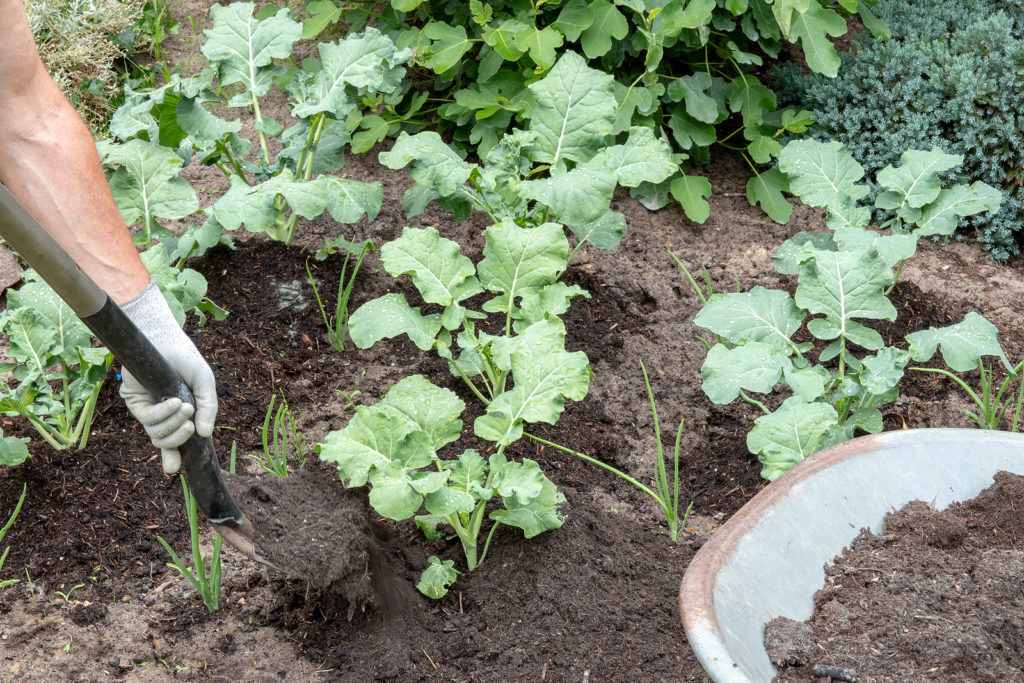
Feeding broccoli
Feed seedlings with liquid fish-and-seaweed fertilizer. When broccoli forms heads feed plants compost tea to help maximize production. Add ½- to 1-inch of compost to the garden bed once plants are established.
Work plenty of compost into the planting bed at planting time and then side-dress broccoli plants with compost at midseason. Avoid high-nitrogen fertilizers which can make stems hollow.
- Give broccoli a nitrogen boost after about three weeks of growth; side-dress broccoli with rotted manure or compost or apply manure tea.
- Side dress plants with well-aged compost at planting time and again at midseason.

Broccoli care
- Keep broccoli planting beds weed-free. Weeds compete with broccoli for water and nutrients.
- Protect young plants with cutworm collars.
- After harvest, pull up the entire plant and compost it.
- Remove all crop residue from the planting bed before winter and gently turn the soil to expose insect larvae to winter cold temperatures.
Broccoli pests
Broccoli can be attacked by a host of pests: Cabbage loopers will eat broccoli from the undersides of leaves. Handpick loopers as soon as you spot them or spray with Bacillus thuringiensis, a biological insecticide. Flea beetles can attack early plantings; exclude them with row covers. Cabbage-root maggots attack at ground level; use paper collars thrust into the soil around the base of plants. Aphids can be sprayed away with water or use insecticidal soap for large infestations.
- Broccoli can be attacked by cutworms, cabbage loopers (caterpillars preceded by small yellow and white moths), imported cabbage worms, cabbage root maggots, slugs, and aphids.
- Place a protective collar around young plants to exclude cutworms.
- Handpick loopers and worms destroy them or spray with insecticidal soap or Bacillus thuringiensis.
- Cabbage maggots are the larvae of a fly. Plant radishes near broccoli to repel the flies. Place row covers over seedlings or set plants through the garden fabric to keep flies from laying eggs in the soil. Mound diatomaceous earth or hot pepper around stems if maggots are in the soil. You can also mix wood ash into the soil near the roots.
- Cutworms and flea beetles will attack young plants.
- Flea beetles nibble holes in young leaves; attacks are worse in dry weather; keeping the soil moist will deter attacks.
- Mealy aphids are gray-green, waxy-looking aphids that suck juices from leaves; squash by hand or introduce ladybugs into the garden.
- A cabbage whitefly is a small white insect; spray with insecticidal soap or Bacillus thuringiensis.
- Caterpillars are the larvae of various types of cabbage white butterflies and moths; these pests eat holes in leaves; insecticidal soap or Bacillus thuringiensis.
- Cabbage root fly: these adult flies lay eggs at the base of young brassica plants; hatched grubs tunnel into roots causing plants to collapse; exclude the flies with row covers; dig up and dispose of collapsed plants.
- Slugs and snails eat ragged holes in leaves; handpick and destroy these pests.
- Birds can attack young seedlings; protect seedlings with netting or row covers.
- To deter insect pests, plant thyme alongside broccoli in a row about 6 inches away. You can also spray plants with a mix of boiled onion and garlic.
- Introducing beneficial insects such as ladybugs and green lacewings can keep pest insects under control.
Broccoli diseases
- Broccoli is susceptible to cabbage family diseases including yellows, clubroot, and downy mildew.
- Plant disease-resistant varieties, rotate crops each year, and keep the garden free of debris to cut back the incidence of disease.
- Remove and destroy infected plants immediately.
- Black rot, also called blackleg, clubroot, and yellows are fungal diseases that can attack cabbage
- Blackleg leaves yellow, V-shaped lesions on leaf edges. Plants with clubroot wilt and look stunted; there will be galls on the roots. Cabbage yellows are marked by the yellowing of lower leaves.
- Blackleg, bacterial blight: control diseases through crop rotation; collect and burn or dispose of in the trash can plant material after harvest.
- Clubroot is a soil-borne disease that results in root swelling followed by yellow leaves, the collapse of the plant, and death. Lift the entire plant and dispose of it in the trash or burn it; do not compost diseased plants
- Downy mildew and yellows can also afflict broccoli plants.
- To avoid fungal diseases plant disease-resistant varieties or seeds that have been hot water treated. Plant in well-drained soil. Water with compost tea.
- Remove and destroy diseased plants immediately.
- Rotate crops on a three-year cycle.
More on broccoli pests and diseases: Broccoli Growing Problems: Troubleshooting.
Extending the broccoli season
Protect broccoli from the cold. Freezing weather will cause broccoli buds to turn purple and can soften the heads—but the flavor will not be adversely affected. Protect against freezing temperatures by placing a floating row cover over plants; this will keep heads 4° to 8°F warmer and extend the harvest by three or four weeks. A plastic tunnel or cold frame can add 10° to 30°F to daytime temperatures.
- The broccoli season can be extended in several ways:
- For an early crop, start plants indoors 10 weeks before the last expected frost. Set plants into the garden in about 5 to 6 weeks.
- Cultivars such as ‘Green Valiant’ can withstand temperatures as low as 20°F. If the weather vacillates between cold and warm, a frost of 27°F will freeze plants.
- Where temperatures are greater than 40°F in winter, grow broccoli as a winter crop.
- A few days after the harvest of the main flower head, side shoots–smaller versions of the central head will begin to grow where leaves join the stem. Side shoots are a second crop. None of the side shoots will grow as large as the first head.
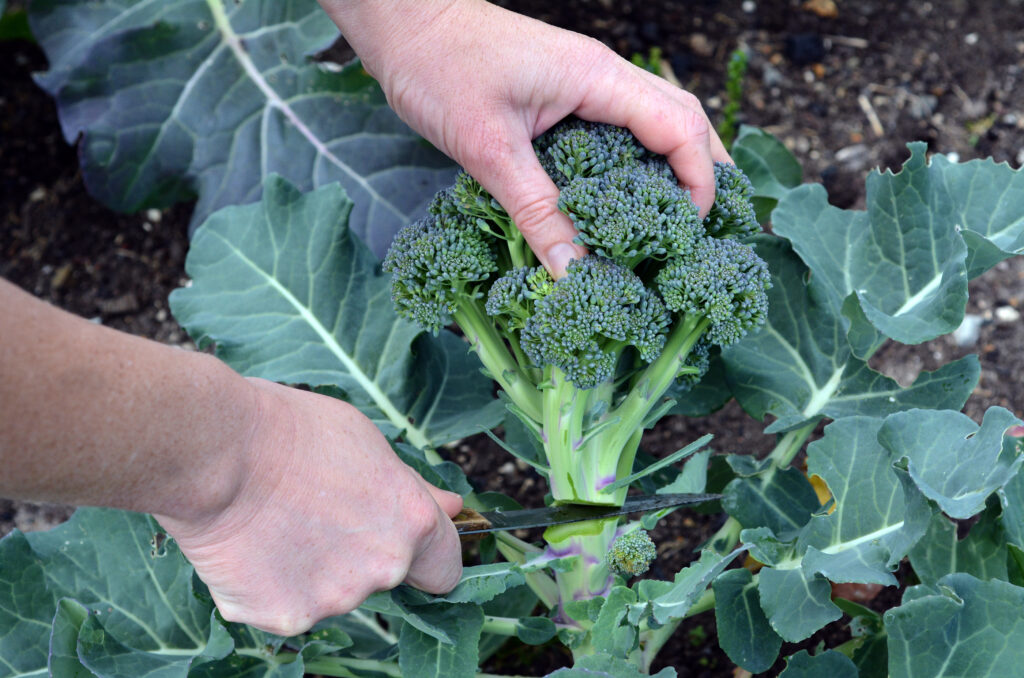
Broccoli harvest
Broccoli will be ready for harvest 80-100 days from direct seeding and 60-80 days from transplanting depending upon variety. Cut off the main or central head when it is 3-4 inches (7-10 cm) in diameter and the flower buds are still tight and green. To encourage secondary shoots to form heads cut away 6 inches (15 cm) of the stem with the central stem. Harvest secondary side shoots when they are 4 inches (10 cm) long.
Harvest broccoli when heads or sideshoots begin to swell and are firm, green, and beaded up—meaning the florets are still close and tight and yellow flower petals have not begun to show. When the head starts to separate, buds will quickly begin to flower. Harvest the central head first; encourage extended side-shoot production by adding a side-dressing of fish meal or aged manure around the base of the plant. Florets will quickly flower in warm weather; quickly remove opening flowers so that the plant will grow more sideshoots. Harvest the central head by cutting the stalk at a slant about 5 to 8 inches below the head. This encourages side shoots. Cut heads in the morning when plants are cool for the best flavor.
- Broccoli grown from seed will come to harvest in 80 to 150 days depending on the variety.
- Grown from transplants broccoli will come to harvest in 55 to 80 days.
- Cut closed flower heads with a sharp knife when they are still green and tight. Cut the central head leaving five to six inches of stem to stimulate many more small broccoli heads to develop. The size of the heads will decrease but they will still be edible.
- Small clusters will grow in the angles of the leaves and can be harvested later. Four to six cuttings of side shoots per plant will follow over several weeks. Harvest side shoots every few days; cut them regularly and the plant will continue to make new shoots. Four to six additional cutting of side shoots can occur.
- Heads that have begun to open showing small yellow flowers are past the eating stage.
- Stems are edible, but they should be peeled to remove the tough outer skin.
- Broccoli leaves are edible but they are tough and best used in soups.
- Soak broccoli heads in salt water (1 to 2 tablespoons of salt per gallon of water) for 30 minutes before cooking or storing; this will drive out any cabbage worms hiding in the heads.
More harvest tips: How to Harvest and Store Broccoli.
How to get a second and third broccoli harvest
Broccoli is easy to grow and offers not one harvest but several.
Each plant grows two to three feet tall with a thick central stalk and several lateral branches. The central stalk is the first to bear a large cluster of tiny, dark green flower buds—the plant’s first harvest. After the central flower cluster is cut the plant will produce several smaller clusters on side branches, as many as six more harvests.
The first flower cluster will form on the central stalk and be as large as 6 inches wide. Harvest the first flower cluster when it turns dark green. Use a knife to cut the flower head. Cut all heads so that a long stub remains on the plant.
Smaller flower clusters will soon sprout on side branches as they lengthen. These flower clusters will be about the size of large buttons. Cut new heads regularly to keep new flowers forming every few days. Each side branch will produce four to six cuttings.
Both the stem and flower buds are edible. Make every effort to harvest buds dark green and full, just before they flower.
The longest broccoli harvest is in the fall as the weather is cooling. In the spring expect regular harvests until the weather warms; warming weather will cause flower buds to open and bloom quickly.
Spring-bearing broccoli plants bolt and flower when temperatures get close to 70°F. When broccoli flower heads begin to open and produce yellow flowers, trim the flowers—they are edible—and add them to salads or soups.
Storing broccoli
Broccoli will keep in the refrigerator crisper for 10-14 days. Blanch heads before freezing for up to 3 months.
- Broccoli will keep in the refrigerator for up to one week if wrapped in plastic.
- Broccoli can be frozen after blanching. Frozen broccoli will keep for up to 3 months.
- Broccoli can be canned, frozen, or pickled.
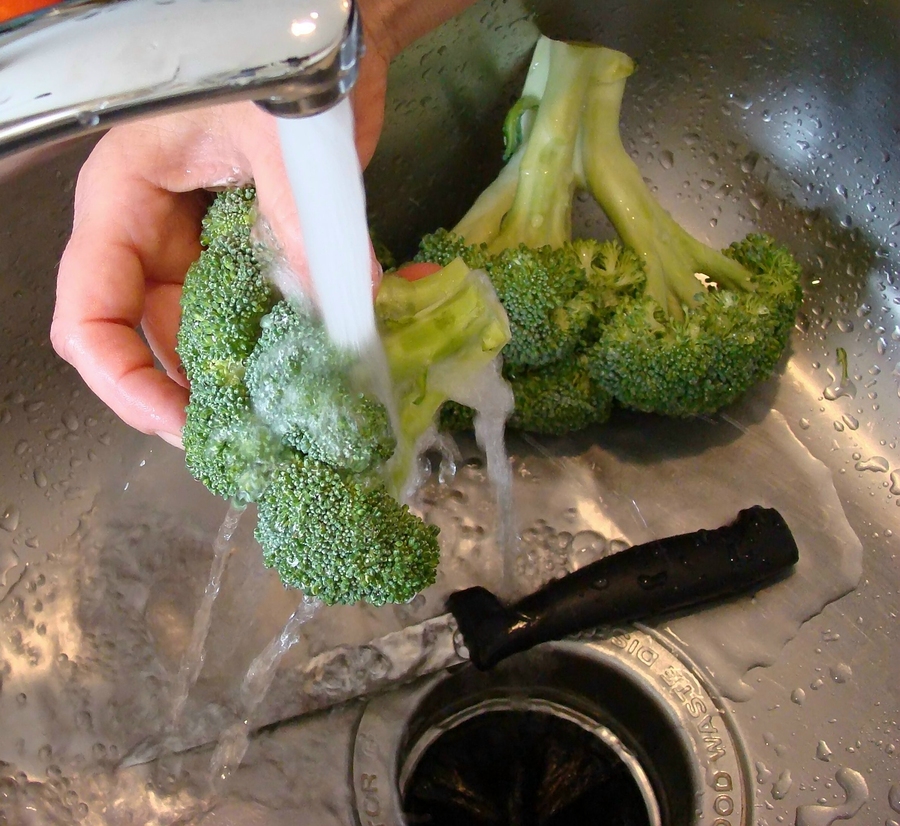
Broccoli in the kitchen
Serve broccoli raw in salads or dips or as a snack. Steam or blanch broccoli until it is tender-crisp and still bright colored (just 5 to 10 minutes); for best flavor do not overcook broccoli. Serve broccoli with a squeeze of lemon or vinaigrette. Soak harvested florets in salted water to remove insects hidden in their heads before serving or cooking.
- Broccoli can be served with cheese or Hollandaise sauce.
- Florets can be broken and used in a salad or with a dipping sauce.
- Stalks can be parboiled and ten sauteed in oil with a little onion and garlic.
- To make sure broccoli stems are cooked adequately, stand stalks in a tall pot so the stem boil and the top steam.
- Purple broccoli turns green when cooked.
Broccoli frequently asked questions
Q: What are the small yellow and white moths flying around my broccoli?
A: These are adult cabbage loopers and imported cabbage worms; the moth lay eggs and caterpillars hatch and eat leaves and flower buds.
Q: What causes broccoli flower heads to be loose and have little yellow flowers?
A: Loose heads with premature flowering are usually the result of weather that is too warm. Plant broccoli earlier in spring.
Q: Can I eat broccoli leaves?
A: Yes, broccoli belongs to the cabbage family and its leaves taste like cabbage, collards, or kale.
Q: Should I tie the leaves of broccoli over its head as I do with cauliflower?
A: No. The leaves of cauliflower are tied over the heads to reduce light and keep the flower heads white–called blanching. Broccoli flower heads do not need to be blanched.
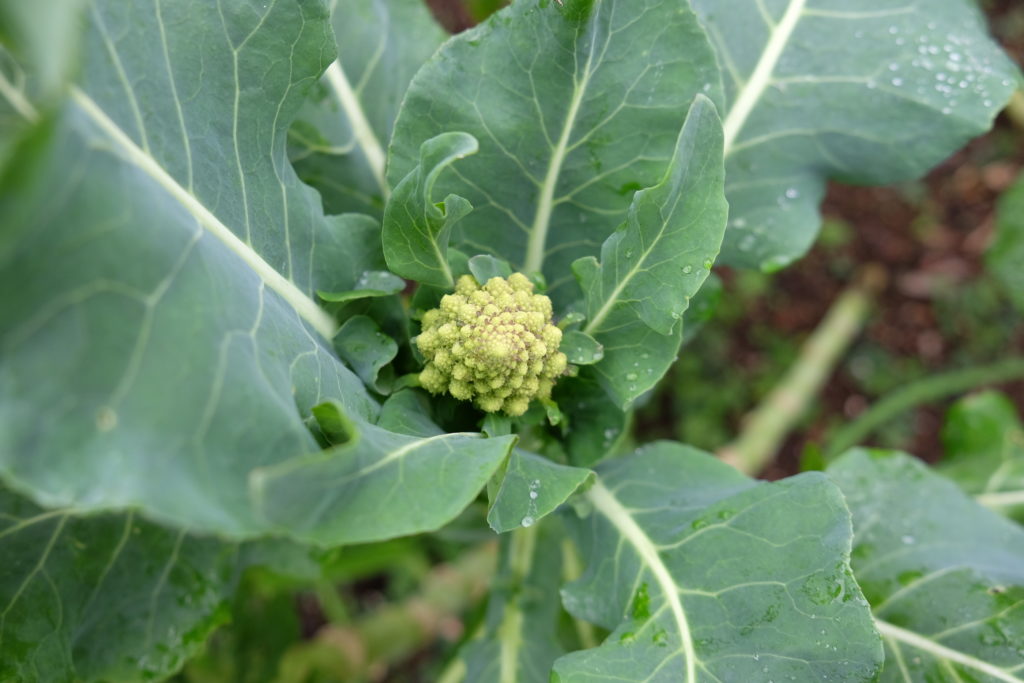
Broccoli varieties to grow
- Arcadia: hybrid; 63 days to maturity; frosty blue-green heads about 8 inches across followed by numerous side shoots; disease resistant and heat and cold tolerant.
- Calabresse: open-pollinated; 58 to 80 days to maturity; great tasting Italian heirloom produces tight, dark-green heads 3 to 6 inches across followed by numerous sideshoots; disease resistant; likes cool weather.
- DeCicco: open-pollinated; 48 to 65 days to maturity; tasty Italian heirloom with small central heads 3- to 4- inches across; the compact plant produces a big harvest.
- Early Purple Sprouting: open-pollinated; 220 to 250 days to harvest; sprouting type English heirloom with numerous sideshoots; overwinters well in mild regions; plant in summer for harvest next spring; hardy to below 10°F.
- Flash: hybrid; 50 days to maturity; sweet tasty flavor, early to harvest with deep green, 6-inch heads of tight beads; good side shoot production following central head; disease and heat-resistant.
- Green Goliath: open-pollinated; 55 days to maturity; large blue-green, domed heads with tight beads, very flavorful; very good side shoot production.
- Gypsy: hybrid; 58 days to maturity; medium green, well-domed heads; great flavor, uniform yield; heat- and disease-tolerant.
- Marathon: hybrid; 62 to 68 days to harvest; large, blue-green heads with fine beads; good side shoot production; widely adapted; very good cold tolerance; disease- and heat-tolerant.
- Packman: hybrid; 55 days to maturity; tightly set beads on the 8-inch domed head; yields smaller heads after the main head is cut; heat tolerant.
- Premium Crop: hybrid; 58 to 62 days to maturity; delicate flavor; deep blue-green heads 9- to 10-inches across, well-domed with fine beads; good side shoot production in fall; disease- and heat-tolerant.
- Romanesco: pale green, large head on a large-leafed plant; 85 days to harvest.
- Rosalind: open-pollinated; 60 to 65 days to maturity; violet-purple heads 6- to 8-inches across; emerald green when cooked; heat-tolerant, best production in cool weather.
- Royal Cruiser: sideshoots almost as large as main heads; 85 days to harvest.
- Spartan Early: dark green heads reach 7 inches across; short, stocky plant; good production of lateral shoots after central head is cut; 58 days to harvest from seedlings.
- Umpqua: open-pollinated; 55 to 60 days to maturity; sweet, tender flavor; large central, well-domed head with fine beads followed by numerous sideshoots.
- Waltham 29: hybrid; 60-95 days to maturity; large, 4- to 6-inch, blue-green heads; very good side shoot production; good for fall growing, withstands very cold temperatures.
- White Sprouting: many creamy yellow buds on a large plant; 70 days to harvest.
More broccoli varieties. ‘Arcadia’ (63 days), ‘Bonanza’ (55 days), ‘Citation, DeCicco’ (48 days), ‘Early Dividend’, ‘Emperor’ (80 days), ‘Eureka’ (87 days), ‘Green Comet’ (78 days), ‘Green Goliath’ (75 days), ‘Green Jewel’, ‘Green Valiant’ (70 days), ‘Gypsy’ (58 days), ‘Happy Rich’ (55 days), ‘Italian Sprouting’ (80 days), ‘Land Mark,’ ‘Legend’ (86 days), ‘Love Me Tender’, ‘Marathon’, ‘Minaret’, ‘Packman’ (80 days), ‘Paragon’ (75 days), ‘Pinnacle Premium Crop’ (58 days), ‘Late Purple Sprouting’ (220 days), ‘Raab Spring, Rapine’ (70 days), ‘Romanesco’ (70 days), ‘Saga’ (57 days),’ Salad’, ‘ShoGun’ (93 days), ‘Small Miracle’, ‘Sprinter, Super Blend’, ‘Super Dome’, ‘Thompson’, ‘Violet Queen’ (70 days), ‘Waltham'(95 days).
Broccoli relatives
- Sprouting broccoli (Brassica oleracea, Italica group) produces longer stems and small clusters of buds, rather than larger heads.
- Broccoli raab or broccoli rabe (B. rapa, Ruvo group) is a turnip raised for its leaves, young, stems, and bud clusters.
Saving broccoli seed
- Broccoli, cabbage, kale, Brussels sprouts, can cauliflower are all bee-pollinated. They all belong to the same family and can cross-pollinate.
- Save broccoli seed only if you are growing a specific variety alone or if different varieties and species are widely separated.
- Broccoli is a biennial so you have to wait for the second year of growth for the production of seeds. Fall-planted broccoli makes seed the next spring.
- Broccoli seed is viable for up to 5 years.
About broccoli
Broccoli is a hardy biennial grown as a cool-season annual. It grows 18 to 36 inches (45-91cm) tall or more and has broad, thick leaves and a thick main stalk. Broccoli forms single or multiple flower “heads ” of tiny blue-green flower buds. The flower heads are eaten before they bloom; buds open to tiny yellow flowers. Broccoli will bolt and go to seed in warm temperatures or when daylight hours lengthen.
Common name. Broccoli, Italian broccoli, Calabrese (British), brocks.
Botanical name. Brassica oleracea italica
Family: Brassicaceae (Cruciferae); other brassica plants include cabbage, kale, Brussels sprouts, cauliflowers
Origin. Mediterranean
Broccoli articles at Harvest to Table:
How to Plant and Grow Broccoli
How to Harvest and Store Broccoli
Broccoli Growing Problems: Troubleshooting
Seven Ways to Cook and Serve Broccoli
Four Ways to Cook and Serve Broccoli Raab
Learn how to plant, grow, and harvest your favorite vegetables. Click below for all you need to know.
- Artichoke
- Arugula
- Asparagus
- Beans, Snap
- Beets
- Broad Beans
- Broccoli
- Brussels Sprouts
- Cabbage
- Cantaloupe — Melons
- Cardoon
- Carrots
- Cauliflower
- Celeriac
- Celery
- Chard
- Chayote Squash
- Chickpeas
- Chicory
- Chinese Cabbage
- Collards
- Corn Salad
- Corn, Sweet
- Cresses
- Cucumbers
- Eggplant
- Endive and Escarole
- Fava Beans
- Florence Fennel
- Garbanzo Beans
- Garlic
- Horseradish
- Jerusalem Artichoke
- Kale
- Kohlrabi
- Leeks
- Lettuce
- Lima Beans
- Melons
- Mizuna
- Mustard Greens
- New Zealand Spinach
- Okra
- Onions
- Parsnips
- Peanuts
- Peas
- Peppers
- Potatoes
- Pumpkins
- Radicchio
- Radishes
- Rhubarb
- Rutabaga
- Salsify
- Shallots
- Sorrel
- Southern Peas
- Soybeans
- Spinach
- Squash, Summer
- Squash, Winter
- Sunchokes
- Sweet Potato
- Swiss Chard
- Taro
- Tomatillo
- Tomatoes
- Turnips
- Watermelon
- Zucchini
Learn to grow 80 tasty vegetables: THE KITCHEN GARDEN GROWERS’ GUIDE
See Garden Products Recommended by Harvest to Table
Garden Planning Books at Amazon:
- Vegetable Garden Grower’s Guide
- Tomato Grower’s Answer Book
- Vegetable Garden Almanac & Planner
- Kitchen Garden Grower’s Guide Vegetable Encyclopedia





